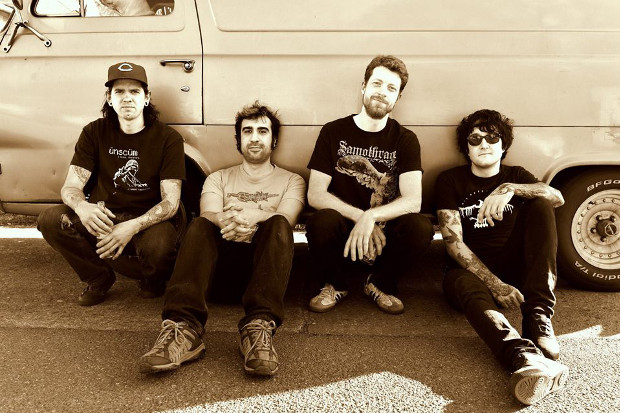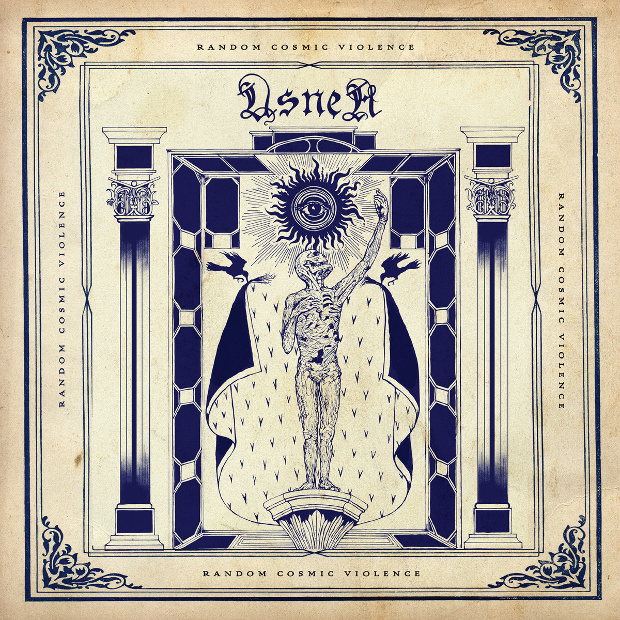Geared Up
Gear Review: Usnea Guitarist and Vocalist Justin Cory on His 1972 Ampeg V4 and 1980 RAT Distortion Pedal
Usnea recently unveiled the full details of their second full-length LP (and Relapse Records debut), Random Cosmic Violence, a four-song sonic masterpiece that was recorded and mixed by Jared “Fester” See at Haywire Studios (Stoneburner, Rabbits, Drunk Dad) and mastered by Brad Boatright at Audiosiege (Yob, High On Fire, Integrity). Recently we chatted with guitarist and vocalist Justin Cory who helped us to better understand how the band got their sludge-laden funeral doom sound on this new recording!

Usnea recently unveiled the full details of their second full-length LP (and Relapse Records debut), Random Cosmic Violence, a four-song sonic masterpiece that was recorded and mixed by Jared “Fester” See at Haywire Studios (Stoneburner, Rabbits, Drunk Dad) and mastered by Brad Boatright at Audiosiege (Yob, High On Fire, Integrity). Recently we chatted with guitarist and vocalist Justin Cory who helped us to better understand how the band got their sludge-laden funeral doom sound on this new recording!
What one piece of gear do you use to obtain your signature sound?
Cory: It’s hard to say that ONE piece of gear gives me my sound, but if it’s not my 1980 first generation RAT distortion pedal, it is the amp I’ve used it in tandem with for over a decade, my 1972 Ampeg V4.
What about it makes it so important to you?
Cory: It was the first real tube amp I ever bought, and when I bought mine in 2004 they were still so undervalued and not truly recognized for their quality and tone. I also lucked out and only paid $350 for mine! But I’ve used this amp in almost every band I’ve played guitar in and it has been reliable the whole time. It has also been crucial to my half of the guitar tone in Usnea; it sounds amazing and crisp when played clean, it is easy to drive it to that “cherry spot” and it takes pedals, especially my RAT, beautifully.

How was this gear used during the recording of your latest album?
Cory: I’ve used this amp on every Usnea record as my main amp for tracking, as well as almost every show we’ve ever played live. The V4 is my main amp, but I also used my late 1970’s Fender Twin for a few parts on the new record as well as Zeke’s (our drummer is also a guitarist and has amassed a mountain of awesome equipment himself) Orange Thunderverb 200 and an amp made by an up-and-coming amp designer-genius; Bryan Sours, that he calls Soursound, made right here in Portland. He is also my amp tech and has modded the V4 various times to increase the headroom, re-cap it when the old caps were going and modding it to run 6550’s instead of the more hard to come by and less than stellar quality 7027 – as it used to take in the power output section. His amps are amazing and I hope to get one someday when I can afford such a thing.
How do you recreate your album (guitar/bass) tones in your live set?
Cory: Well, I use the V4 live of course! But having nice cabs also helps, and I run it through an Orange 4×12 loaded with well-loved and broken in Celestion v30s and an Emperor 4×12 loaded with Eminence Wizards. The Ampeg V4 is a monster of an amp and it performs great in a live setting.
What are the major pros and cons?
Cory: Pros would be that it is loud and sounds great, it was cheap when I bought it, it is fairly cheap to maintain and re-tube, and it is reliable considering it’s a 40 year old amplifier. Cons would be that obviously there is no customer service available from Ampeg for this amp since it’s so old and is not in production any longer, so if you are going to play one you had better find and befriend an excellent amp tech who knows how to work on these things. Bryan Sours is definitely the best I’ve ever encountered. Another potential con for some might be that it has no pedal-switchable amp distortion, but as I said, it takes pedals really well and there are more than a few great over-drives, fuzzes, and distortion stomp boxes out there. You could also just dime the volume and get a seriously awesome overdrive from pushing the amp itself, though Usnea tends to need more dynamic capability than that.
Do you have a backup for this gear, if so, what?
Cory: In the rare occurrences, and they’ve seldom happened, that the amp has broken down, Zeke has always been rad about lending me his Orange Thunderverb 200 to play live and at practices. I would like to get another 100+ watt tube head as a back-up and maybe to use interchangeably, but it’s not my first financial priority right now.
How long have you had it, how do you use it, would you ever change it?
Cory: I’ve had it for almost 11 years now, since early 2004. I will never get rid of it or replace it because I really love the tone and possibilities of this head. If I did get another head though, my top choices would be a ’70’s Hiwatt DR-103 Custom 100 or a Soursound 150 watt.
Give us your best “gear goes wrong” story.
Cory: Hmm… This amp has never really gone wrong on ME live or in a way that is an interesting story. I did used to drive bands on tour and I rented it out as part of a back-line sometimes. On one occasion it just took a shit in the middle of the set for the band I was renting it to. They borrowed an amp from someone else on the bill and finished their set. I felt really bad and plus I was renting it to them so I carried it into the bathroom of the DIY warehouse space in Eureka, CA where the show was because it was the only place I could get away from the crowd and have some quiet. I took the chassis out to trouble shoot. It was a bigger bummer because someone had just taken a nasty-smelling crap in there. Anyhow, I called Bryan Sours and he actually answered that late at night (talk about being a bad-ass friend and all around helpful amp tech) and after I explained in detail what happened when it went on the fritz, he told me it was probably the screw holding the reverb lock spring in place that had come loose and was rattling around in the amp and he was totally correct. I found the screw and used my crappy leatherman to put if back where it goes and patch the whole thing up and it worked on the rest of the tour and beyond that without a hitch.
Any final thoughts or comments on the gear?
Cory: Ampeg used to make amazing amps, I wish they would get back to it. But regardless, their 1970s and 1980s stuff is pretty damn legendary. If I were playing bass in a band, I would try to get my hands on one of the original Ampeg SVTs from that era, they are the holy grail of bass amps in my opinion. The Ampeg V4 is still an affordable tone-rich alternative to all of the vintage trendy amps (ahem… Sunn) that was made super well and can go head to head with almost any high output tube head out there.
Check out the song “Healing Through Death”
-

 Music4 days ago
Music4 days agoTake That (w/ Olly Murs) Kick Off Four-Night Leeds Stint with Hit-Laden Spectacular [Photos]
-

 Alternative/Rock6 days ago
Alternative/Rock6 days agoThe V13 Fix #010 w/ High on Fire, NOFX, My Dying Bride and more
-

 Hardcore/Punk2 weeks ago
Hardcore/Punk2 weeks agoHastings Beat Punks Kid Kapichi Vent Their Frustrations at Leeds Beckett University [Photos]
-

 Alternative/Rock2 weeks ago
Alternative/Rock2 weeks agoA Rejuvenated Dream State are ‘Still Dreaming’ as They Bounce Into Manchester YES [Photos]
-

 Features4 days ago
Features4 days agoTour Diary: Gen & The Degenerates Party Their Way Across America
-

 Culture1 week ago
Culture1 week agoDan Carter & George Miller Chat Foodinati Live, Heavy Metal Charities and Pre-Gig Meals
-

 Music7 days ago
Music7 days agoReclusive Producer Stumbleine Premieres Beat-Driven New Single “Cinderhaze”
-

 Alternative/Rock1 week ago
Alternative/Rock1 week agoThree Lefts and a Right Premiere Their Guitar-Driven Single “Lovulator”













